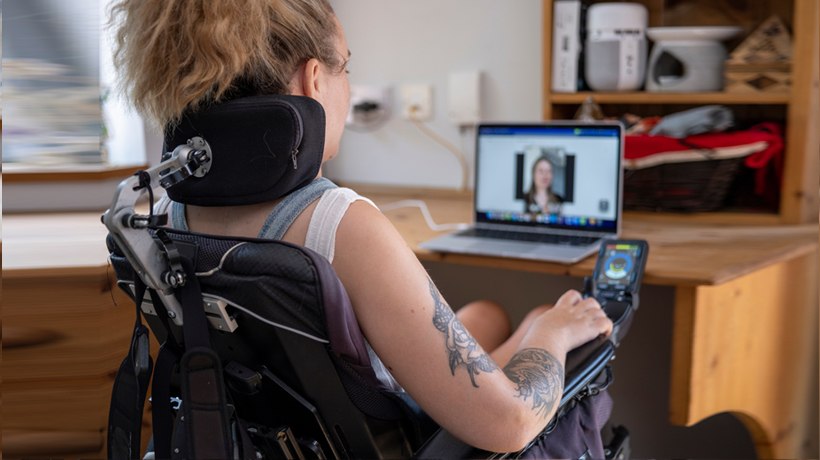What You Need To Enable Accessibility In Learning
In today’s digital age, accessibility is no longer just an afterthought; it has become an imperative. The concept of accessibility goes beyond physical accommodations; it encompasses the design and implementation of technologies, products, and services catering to the various needs of all individuals. By embracing accessibility, we not only ensure equal participation and opportunities for everyone but also unlock the full potential of our digital landscape. In this article, we will explore the significance of accessibility in building an inclusive world, the impact of accessibility, critical accessibility standards to follow, and key considerations for accessibility in L&D.
6 Ways Accessibility Positively Impacts Society
Accessibility is a practice that involves the designing and provisioning of products, services, and environments that are usable and inclusive for all individuals, including those with disabilities, seniors, and people with diverse abilities. Accessibility has a significant impact on various aspects of society, including the following.
1. Inclusion And Equality
Accessibility promotes inclusion and equality. It removes barriers that hinder people with disabilities, thus allowing them to fully participate in society. It ensures individuals with disabilities have equal access to information, services, employment opportunities, education, transportation, and other essential aspects of life, enabling them to lead independent and fulfilling lives.
2. Economic Empowerment
Accessibility can positively impact the economic well-being of individuals with disabilities by creating opportunities for employment and entrepreneurship. When workplaces, websites, and services are accessible, people with disabilities can participate in the workforce, contribute to the economy, and achieve financial independence.
3. Social Participation
Accessibility facilitates social participation by enabling individuals with disabilities to fully engage in social, recreational, and cultural activities. It ensures public spaces, events, and digital platforms are accessible, allowing people with disabilities to connect with others, access information, and participate in social and cultural life.
4. Innovation And Creativity
Accessibility drives innovation and creativity in product design, technology, and services. When accessibility is integrated into the design process, it often leads to innovative solutions that benefit not only people with disabilities but also the broader population. For example, curb cuts initially designed for wheelchair users are now used by cyclists, parents with strollers, and travelers with luggage.
5. Legal And Ethical Obligations
Accessibility is a moral obligation. In addition, it is a legal requirement in many countries. Laws and regulations mandate accessibility in various domains, such as the built environment, transportation, information and communication technology (ICT), and public services.
For example, the Americans with Disabilities Act (ADA) in the United States, the European Accessibility Act in the European Union, and the Accessibility for Ontarians with Disabilities Act (AODA) in Canada are some of the legal frameworks that establish accessibility requirements. Organizations must comply with these requirements if they want to make their products, services, and environments accessible to all.
6. Human Rights
Accessibility is a fundamental human right as recognized by the Convention on the Rights of Persons with Disabilities. Access to information, education, employment, transportation, and public services are basic human rights. Accessibility plays a critical role in ensuring these rights are upheld for individuals with disabilities.
5 Vital Accessibility Facts Organizations Must Know
Here are some interesting facts about accessibility and how the world is embracing it.
1. Global Prevalence Of Disabilities
An estimated 1.3 billion people experience significant disability, according to the World Health Organization. This represents 16% of the world’s population, or 1 in 6 of us. Disabilities can be physical, sensory, cognitive, or mental in nature, and they can impact individuals of all ages and backgrounds.
2. Aging Population And Accessibility
The global population is aging rapidly. By 2050, there will be an estimated population of 2.1 billion people aged 60 and older. Aging is often associated with increased risk of disabilities, such as visual or hearing impairments, mobility limitations, and cognitive decline. This highlights the significance of accessibility in accommodating the needs of older adults.
3. Web Accessibility
Web accessibility refers to the design of websites and web content that can be easily used by people with disabilities. According to Pew Research Center, 75% of Americans with disabilities use the internet every day.
However, studies have shown that many websites still do not meet the basic accessibility standards. 96.3% of home pages had detectable WCAG 2 failures, according to WebAIM. This is posing barriers for people with disabilities to access online content.
4. Accessibility In The Workplace
In many countries, including the United States, Canada, the European Union, and Australia, employers are needed to provide reasonable accommodations to workers having disabilities. This is to ensure equal opportunities and access to employment are provided to all employees.
According to the Bureau of Labor Statistics, the employment-population ratio for people with a disability was 21.3% in 2022. From the time comparable data were first published in 2008, this ratio was the highest on record, which emphasizes the need to identify employment gaps and the importance of workplace accessibility.
5. Economic Impact Of Accessibility
The economic impact of accessibility is significant. According to the 2022 Valuable Truth Report, the disabled community represents $8 trillion per year in disposable income. This number goes up to $13 trillion when friends and family are included.
Accessible products, services, and environments can create opportunities for employment, entrepreneurship, and economic participation for people with disabilities, contributing to economic growth and societal well-being.
Technological innovation plays a crucial role in advancing accessibility. Innovative solutions, such as assistive technologies, accessible user interfaces, and inclusive design approaches, are continuously emerging. The world can leverage advancements in Artificial Intelligence, robotics, and wearable devices to improve accessibility and support the lives of people with disabilities.
Accessibility is a critical aspect of ensuring equal opportunities, inclusion, and participation for people with disabilities. Emphasizing and promoting accessibility can lead to a more inclusive and equitable society for everyone.
5 Common Accessibility Standards To Swear By
Web accessibility standards typically cover a broad scope of accessibility issues, including but not limited to visual, hearing, mobility, and cognitive impairments. They provide guidance on various aspects of web design and development, such as color contrast, alternative text for images, keyboard accessibility, and video captions.
It’s important for web developers and organizations to understand and adhere to web accessibility standards to ensure their websites and web content are inclusive and usable by all individuals, including those with disabilities.
Following web accessibility standards not only promotes equal access to information and services for people with disabilities but also helps organizations comply with relevant laws and regulations. It can also help enhance the overall experience for all users.
There are several established web accessibility standards that are widely recognized and followed by web developers and organizations around the world. Some of the most referenced web accessibility standards include the ones below.
1. Web Content Accessibility Guidelines (WCAG)
Developed by the World Wide Web Consortium (W3C), WCAG is a set of guidelines that provides technical and non-technical recommendations for making web content accessible to people with disabilities. It has different levels of conformance, including Level A, Level AA, and Level AAA, with Level AA being the most referenced level.
2. Accessible Rich Internet Applications (ARIA)
ARIA is a compilation of attributes that are added to HTML elements to make them more accessible to people with disabilities. ARIA is particularly useful for improving the accessibility of dynamic web content, such as web applications, by providing additional information to screen readers and other assistive technologies.
3. Section 508
Section 508 of the Rehabilitation Act is a United States federal law that requires federal agencies to ensure their electronic and information technology (EIT) is accessible to people with disabilities. It sets forth technical standards for web accessibility that are based on WCAG 2.0 Levels A and AA.
4. EN 301 549
EN 301 549 is a European standard that provides accessibility requirements for ICT products and services, including websites and web content. It is based on WCAG 2.1 Level AA and is often referenced in European countries for web accessibility compliance.
5. ISO/IEC 40500
Also known as WCAG 2.0, ISO/IEC 40500 is an international standard providing guidelines to make web content accessible for people having disabilities. It is based on WCAG 2.0 Levels A and AA.
Differences Between Section 508 And WCAG
Section 508 and WCAG are two sets of guidelines related to accessibility for people with disabilities. However, they have some differences in terms of scope, application, and legal requirements.
1. Scope
Section 508 specifically applies to electronic and information technology accessibility in the federal sector, including federal agencies, contractors, and organizations receiving federal funding. It requires that EIT be accessible to individuals having disabilities, including those with cognitive, visual, motor, neurological, and auditory disabilities.
On the other hand, WCAG is a set of international guidelines developed by the W3C that provides recommendations for making web content accessible for people with different types of disabilities. WCAG applies to all websites and web content, regardless of the sector or organization.
2. Legal Requirements
Section 508 is a legal requirement in the United States for federal agencies, contractors, and organizations receiving federal funding. Non-compliance with Section 508 can result in legal action and financial penalties. Compliance with Section 508 is mandatory for covered entities.
WCAG, on the other hand, is not a legal requirement by itself, but it is widely recognized and referenced as a standard for web accessibility. However, in some jurisdictions, adherence to WCAG may be required by law, or it may be used as a reference in legal proceedings.
3. Technical Standards
Section 508 has specific technical standards that must be followed, which were last updated in 2017 and are based on WCAG 2.0. These technical standards are focused on ensuring EIT, including websites, software, and other digital content, is perceivable, operable, understandable, and robust (POUR) for individuals with disabilities.
WCAG, on the other hand, is a more comprehensive and updated set of guidelines, with the latest version being WCAG 2.1. This version includes additional criteria to address mobile accessibility, content that changes dynamically, and other accessibility considerations.
6 Legal Implications Of Noncompliance With Accessibility Standards
Organizations that don’t have accessibility standards in place face various legal implications, depending on the country and jurisdiction they are operating in. The potential legal consequences of not adhering to accessibility standards may include the following.
1. Discrimination Lawsuits
Individuals with disabilities who encounter barriers to access, such as inaccessible websites, facilities, or services, may file discrimination lawsuits against the organizations. These lawsuits can be filed under anti-discrimination laws, such as the ADA in the United States, the Equality Act in the United Kingdom, or the Canadian Human Rights Act. They can result in financial penalties, compensatory damages, and legal fees.
2. Compliance Violations
Organizations may face fines, penalties, or sanctions for noncompliance with accessibility standards mandated by laws or regulations. For example, in the European Union, the Web Accessibility Directive requires public sector websites and mobile applications to be accessible. Noncompliance with the Directive may result in financial penalties.
3. Loss Of Business Opportunities
Organizations that don’t meet accessibility standards may lose business opportunities, especially in the public sector or when competing for contracts with accessibility requirements. Many governments and organizations require accessibility compliance as a prerequisite for procurement or business partnerships.
4. Reputational Damage
Failure to adhere to accessibility standards can result in negative publicity, reputational damage, and loss of public trust. In the era of social media and online reviews, news of inaccessible products, services, or facilities can spread quickly, resulting in reputational harm that may impact the organization’s brand, customer loyalty, and market share.
5. Legal Barriers To Market Entry
In some cases, organizations may face legal barriers to enter certain markets or industries if they don’t meet accessibility standards. For instance, industries such as telecommunications, transportation, and finance may have specific accessibility requirements that organizations must meet to operate in those sectors.
6. Remediation Requirements
If an organization is found to be noncompliant with accessibility standards, it may be required to remediate the accessibility issues. This could involve costly modifications to websites, facilities, products, or services to bring them into compliance.
6 Key Considerations For Accessibility In L&D
The accessibility of Learning and Development (L&D) content is essential to ensure individuals with disabilities fully participate in educational and professional opportunities. Here are some important considerations for the accessibility of L&D content.
1. Digital Accessibility
L&D content can be delivered through various digital platforms, such as online courses, eLearning modules, webinars, and educational websites. It is essential to design and develop these digital platforms and content in accordance with web accessibility standards like WCAG. This is to ensure individuals with disabilities access and interact with the L&D platforms and content effectively.
2. Alternative Formats
Providing alternative formats of L&D content, such as closed captioning for videos, transcripts for audio content, and accessible documents like PDFs with proper tagging, can make the content accessible to individuals with hearing or visual impairments. These alternative formats can ensure individuals with disabilities access the information in a way that best suits their needs and preferences.
3. Inclusive Design
Inclusive design principles should be integrated into the creation of L&D content. This includes considering the needs and preferences of diverse learners, including those with disabilities, from the beginning of the content creation process. Designing content with accessibility in mind can help prevent potential barriers and ensure the content is usable and inclusive for all learners.
4. Assistive Technologies
Many individuals with disabilities use assistive technologies, such as screen readers, speech recognition software, or alternative input devices, to access and interact with digital content. It is important to ensure L&D content is compatible with commonly used assistive technologies and can be navigated and understood effectively using such technologies.
5. Training And Awareness
Educators, Instructional Designers, and content creators should receive training and be aware of accessibility best practices to ensure L&D content is created with accessibility in mind. This includes understanding accessibility guidelines, testing content for accessibility, and addressing any accessibility issues that may arise.
6. Legal Requirements
In many countries, educational institutions and organizations are needed to meet the legal requirements for accessibility, including those for L&D content.
For example, in the United States, educational institutions that receive federal funding are required to provide accessible learning materials and technologies under Section 504 of the Rehabilitation Act and the ADA. Compliance with these legal requirements is important to ensure people with disabilities are provided equal access to L&D opportunities.
The accessibility of L&D content involves considerations such as digital accessibility, alternative formats, inclusive design, compatibility with assistive technologies, training and awareness, and compliance with legal requirements. By prioritizing accessibility in the design and delivery of L&D content, organizations can create an inclusive learning environment that benefits all learners, including those with disabilities.
End Note
Accessibility is not a luxury; it is a fundamental right. By embracing the principles of accessibility, we can bridge the digital divide and create a world that values diversity and inclusion. Designing and developing products and services with accessibility in mind not only benefits people with disabilities but also enhances the experiences of all users. As we continue to navigate the digital landscape, let us remember that true progress lies in building a future that is accessible to everyone.









